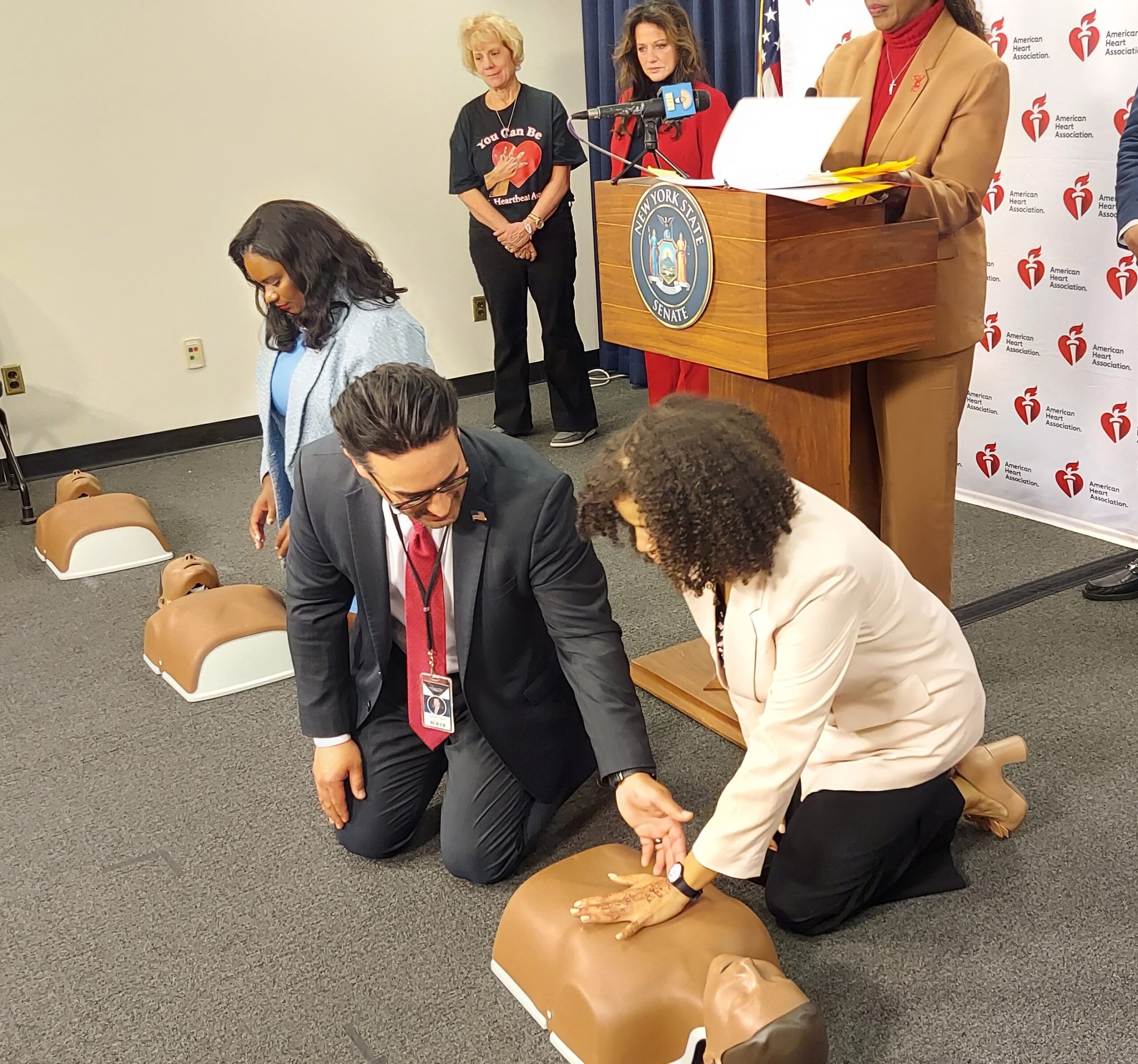Every year, 356,000 people have a sudden cardiac arrest. Only 10 percent survive. The good news is that having CPR performed doubles or triples a victim’s chance of survival. That’s why the American Heart Association is creating a Nation of Lifesavers, where at least one member of every household knows how to do Hands-Only CPR.

That nation grew on Tuesday, April 8, as members of the New York state Senate and New York state Assembly learned Hands-Only CPR during a day-long “CPR Showdown” at the Capitol.
19 Senate members squeaked by 18 Assembly members who learned this skill. Members of the public joined in, with a total of 250 people taking five minutes to learn Hands-Only CPR.
American Heart Association advocates took the opportunity to remind the legislators of the importance of legislation calling for Cardiac Emergency Response Plans (CERPs) in New York’s schools. Senator April M.N. Baskin is the sponsor of S.5539 and Assemblymember Michaelle C. Solages is sponsoring A.785, bills that would create CERPS in schools.
“When the unthinkable happens and a cardiac event occurs on a school property, every second counts,” said Sen. Baskin. “With a Cardiac Emergency Response Plan and AEDs on-site, the stricken individual will have a much better chance to survive. These critical resources, available to students, staff, and visitors, can buy time before professional medical help arrives.”
“This CPR showdown is more than a competition—it’s about preparing New Yorkers to save lives,” said Assemblymember Solages. “With Cardiac Emergency Response Plans in our schools and more people learning Hands-Only CPR, we’re building a safer future for our students and communities. I’m proud to sponsor this legislation and look forward to joining the American Heart Association and my colleagues in showing that New York is ready to lead on this.”
Terry Dehler, R.N., St. Peter’s Health Partners, knows too well the pain of losing someone to sudden cardiac arrest.
“My son Vinny passed away of a sudden cardiac arrest, and I’m advocating for Cardiac Emergency Response Plans as a tribute to him,” said Dehler. “He was only 21. Cardiac Emergency Response Plans replace chaos with clarity. They ensure that in the first moments of a cardiac emergency, there is a plan, there are trained people, and there is hope. As a nurse, I know the hard truth: the first responders to sudden cardiac arrest are rarely professionals. They’re bystanders, students, parents, friends, often paralyzed by fear and uncertainty. Minutes slip by. And with every passing minute, the odds of survival plummet.”
Ann Furner of Utica is one of the 10% who survive a sudden cardiac arrest each year. When she had a sudden cardiac arrest at church in 2023, fellow parishioners – who included a firefighter – took immediate action.
Lansingburgh Central School District already has a Cardiac Emergency Response Plan in place.
“At Lansingburgh, protecting the lives of our students, staff, and community isn’t just a priority — it’s a promise, said Matt Hickling, CPNC-PC, MSN, RN, district medical director, Lansingburgh Central School District. “We created our Cardiac Emergency Response Plan (CERP) because in a cardiac emergency, every second can mean the difference between life and death. This plan equips our staff to respond immediately, with clarity and confidence, ensuring no time is lost when it matters most. We bring the plan to life through hands-on drills, working closely with our School Resource Officer and local EMS to simulate real scenarios and strengthen our response as a team. It’s more than a protocol—it’s a reflection of our unwavering commitment to the safety of our district.”
“We want to thank and congratulate the people who learned Hands-Only CPR today,” said Kaweeda Adams, advocacy ambassador for the American Heart Association in the Capital Region, and past superintendent of the Albany City School District. “They are making New York a safer place to be. We urge the Legislature to pass legislation so each school has a Cardiac Emergency Response Plan in place. This is the next step in the American Heart Association’s work to strengthen the chain of survival. We passed the CPR in Schools law, and assisted with Louis’ Law, which put AEDs in New York’s public schools. Our schools are community gathering places, and having a Cardiac Emergency Response Plan, we equip educators, staff and students with the knowledge, skills, and resources necessary to act confidently during cardiac emergencies.”